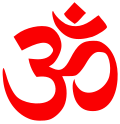| Part of a series on |
| Hindu scriptures and texts |
|---|
 |
| Related Hindu texts |
Hinduism is an ancient religion, with denominations such as Shaivism, Vaishnavism, Shaktism, among others. [1] [2] Each tradition has a long list of Hindu texts, with subgenre based on syncretization of ideas from Samkhya, Nyaya, Yoga, Vedanta and other schools of Hindu philosophy. [3] [4] [5] Of these some called Sruti are broadly considered as core scriptures of Hinduism, but beyond the Sruti, the list of scriptures vary by the scholar. [6]
Contents
Several lists include only the Vedas, the Principal Upanishads, the Agamas and the Bhagavad Gita as scriptures broadly accepted by Hindus. [6] [7] Goodall adds regional texts such as Bhagavata Purana and Yajnavalkya Smriti to the list. [6] Beyond the Sruti, Hindu texts include Smritis, Shastras, Sutras, Tantras, Puranas, Itihasas, Stotras, Subhashitas and others. [8] [9]
Most of these texts exist in Sanskrit, [10] [11] and Old Tamil, and also later in other Indic languages. In modern times, most have been translated into other Indian languages and some in Western languages. [12] [13] This list includes major Hindu texts, along with the Hindu scriptures.

